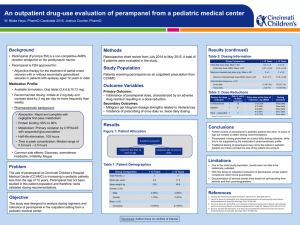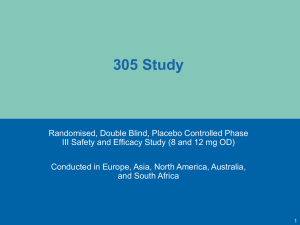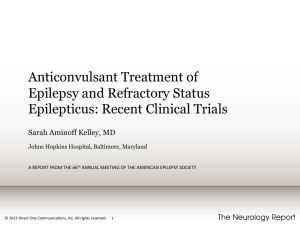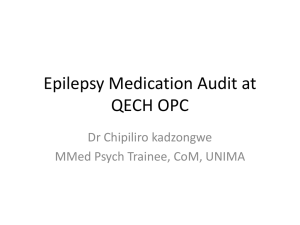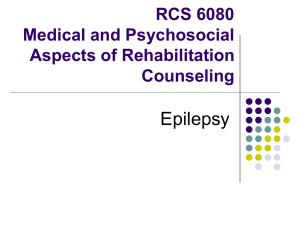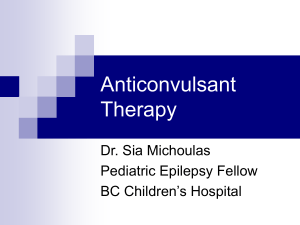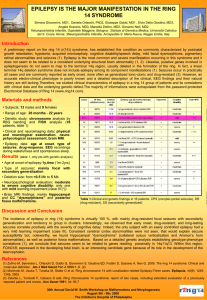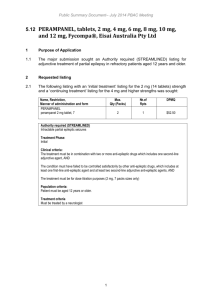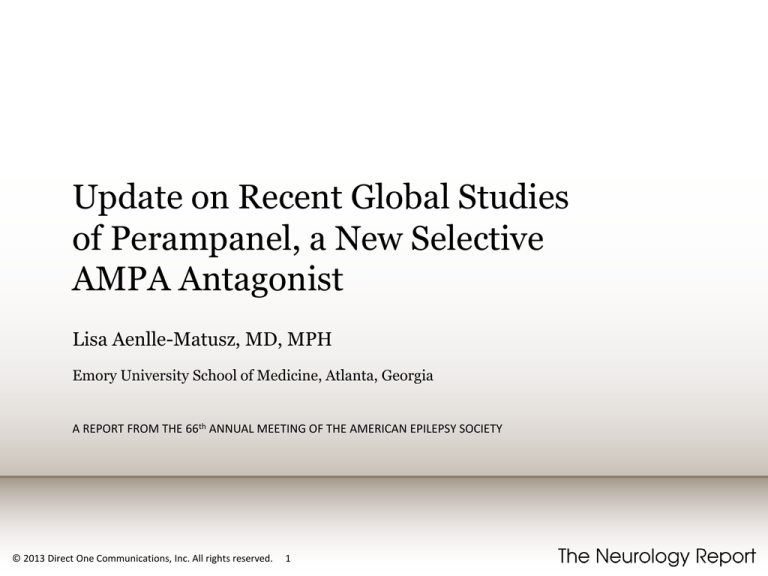
Update on Recent Global Studies
of Perampanel, a New Selective
AMPA Antagonist
Lisa Aenlle-Matusz, MD, MPH
Emory University School of Medicine, Atlanta, Georgia
A REPORT FROM THE 66th ANNUAL MEETING OF THE AMERICAN EPILEPSY SOCIETY
© 2013 Direct One Communications, Inc. All rights reserved.
1
Perampanel
Approved by the FDA and European Commission for
adjunctive therapy of partial-onset seizures, with or
without secondarily generalized seizures, in patients
with epilepsy 12 years of age
Specifically targets -amino-3-hydroxy-5-methyl-4isoxazolepropionic acid (AMPA) receptors
Mainly metabolized by the cytochrome P 3A4
(CYP3A4) system
Clearance increased in patients who are also using
carbamazepine, oxcarbazepine, and/or phenytoin1
© 2013 Direct One Communications, Inc. All rights reserved.
2
Global Phase III Studies of Perampanel
Data derived from three international, placebocontrolled, phase III trials:
» Study 304 (North, Central, and South America)2
» Study 305 (North America, Europe, Asia, South Africa, and
Australia)3
» Study 306 (Australia, Europe, and Asia)4
Patients 12 years of age with uncontrolled partial
seizures despite treatment with up to three
antiepileptic drugs (AEDs) were randomized to
receive:
» 8 or 12 mg of perampanel or placebo once daily (studies 304
and 305) or
» 2, 4, or 8 mg of perampanel or placebo once daily (study 306)
© 2013 Direct One Communications, Inc. All rights reserved.
3
Global Phase III Studies of Perampanel
All three studies included 6 weeks of baseline
therapy, 6 weeks of dosage titration, and 13 weeks of
maintenance therapy.
Patients kept track of seizure activity using daily
diaries.
© 2013 Direct One Communications, Inc. All rights reserved.
4
Response Rates and Seizure Freedom
Among 1,478 patients in the pooled ITT dataset, daily
administration of 4–12 mg of perampanel resulted in
higher 50% and 75% response rates and freedom from
seizures than did placebo.5
© 2013 Direct One Communications, Inc. All rights reserved.
5
Response Rates and Seizure Freedom
Response rates for all patients with partial-onset
seizures improved at higher perampanel doses,
irrespective of the concomitant AEDs used.5
Previous analyses showed use of 8 mg of perampanel
to be more beneficial than 12 mg.6
Pharmacokinetic and pharmacodynamic data
showed a linear exposure-efficacy relationship across
doses of 2–12 mg/d no matter which AEDs were
being taken concomitantly.7
© 2013 Direct One Communications, Inc. All rights reserved.
6
Response Rates and Seizure Freedom
Patients were taking a mean of 2.2 concomitant
AEDs at baseline, most commonly carbamazepine,
valproic acid, lamotrigine, and levetiracetam.5
» Improvements in 50% response rates observed with 8 or 12
mg/d of perampanel vs placebo were roughly the same
regardless of dose.
Greater improvements were noted with concomitant
valproic acid, lamotrigine, or levetiracetam than with
concomitant carbamazepine.
» Carbamazepine increases perampanel clearance but does
not affect the relationship between perampanel plasma
levels and therapeutic response.8
© 2013 Direct One Communications, Inc. All rights reserved.
7
Response Rates and Seizure Freedom
When compared with the placebo group, patients
given 4 mg of perampanel plus valproic acid or
lamotrigine showed improvement in all partial-onset
seizures and complex partial with secondary
generalized seizures.
© 2013 Direct One Communications, Inc. All rights reserved.
8
Impact on Seizure Frequency
When compared with placebo, adjunctive treatment
with 4–12 mg/d of perampanel over 28 days reduced
the frequency of partial-onset and secondary
generalized seizures, regardless of the AEDs taken
concomitantly.9
Greatest differences between perampanel and
placebo were achieved with 8 mg/d of perampanel
for partial-onset seizures (–28.8% vs –12.8%,
respectively), complex partial seizures with
secondary generalized seizures (–35.6% vs –13.9%),
and only secondary generalized seizures (–62.9% vs
–19.4%).9
© 2013 Direct One Communications, Inc. All rights reserved.
9
Impact on Seizure Frequency
No significant difference in seizure frequency was
found between 8 mg/d and 12 m/d of perampanel.9
Other analyses within this same patient population
showed a greater response with 12 mg/d of
perampanel versus 8 mg/d.6
© 2013 Direct One Communications, Inc. All rights reserved.
10
Efficacy and Safety in North America
Information on North American patients (United
States, n = 294; Canada, n = 25) was derived from
the two phase III North American studies.2,3
Most patients had complex partial seizures, both
with and without secondary generalization.
Participants were 12 years of age and had
refractory partial-onset seizures despite treatment
with up to three concomitant AEDs.
© 2013 Direct One Communications, Inc. All rights reserved.
11
Efficacy and Safety in North America
Median reduction in all partial-onset seizure
frequency over 28 days was 28% in patients taking
8 mg/d of perampanel and 25% among those taking
12 mg/d. 10
» Among patients with complex partial and secondary
generalized seizures, the most significant reduction (35%)
occurred among patients taking 8 mg/d.
» Among those with only secondarily generalized seizures, a
65% reduction in seizure frequency was observed among
those taking 8 or 12 mg/d of perampanel.
Adjunctive perampanel therapy was associated with
a favorable safety profile and tolerability consistent
with the global study population.
© 2013 Direct One Communications, Inc. All rights reserved.
12
Quality of Life
Krauss et al11 assessed the relationship between
quality of life and frequency of refractory partial
seizures among patients enrolled in the three global
phase III studies of perampanel.2–4
Patients (age 18 years) had partial-onset seizures
that remained uncontrolled despite therapy with up
to three AEDs at baseline.
The Quality of Life in Epilepsy (QOLIE)-31P
questionnaire was administered at baseline and
again at the end of treatment.
© 2013 Direct One Communications, Inc. All rights reserved.
13
Quality of Life
Significant improvements in quality of life were
associated with a 50% reduction in seizure
frequency in both patients receiving placebo and
those given perampanel.
One third of 903 patients given perampanel
responded to the drug.
Complete data for inclusion in the multivariate
analysis were available for 742 patients.
62.4% of patients had a baseline QOLIE-31P score
< 50.
The mean improvement in QOLIE-31P scores at the
end of treatment was 12.5% (P = 0.01).
© 2013 Direct One Communications, Inc. All rights reserved.
14
Quality of Life
Marginal changes in overall QOLIE-31P scores and
in the domains of emotional well-being, seizure
worry, energy-fatigue, distress, medication effects,
and overall health status were significantly improved
in 50% of responders when compared with
nonresponders.11
In all responders, with increase in response rates
from 20% to 100%, there was a greater increase in
marginal overall QOLIE-31P score changes and in
the general domain areas of emotional well-being
and social function.11
© 2013 Direct One Communications, Inc. All rights reserved.
15
Quality of Life
© 2013 Direct One Communications, Inc. All rights reserved.
16
Quality of Life
In epilepsy-specific domains (seizure-worry and
health status), there also was a greater increase in
QOLIE-31P scores as the response level increased.11
Responders had a greater mean improvement in
overall QOLIE-31P scores (an additional 21.1%
beyond that achieved in nonresponders) and the
subscales for seizure-worry (55.3%), cognitive
function (35.1%), and emotional well-being (38.1%)
that were statistically significant.
© 2013 Direct One Communications, Inc. All rights reserved.
17
Quality of Life
© 2013 Direct One Communications, Inc. All rights reserved.
18
Quality of Life
These mean improvements were greater than the
minimally important difference (MID).
A 48% reduction in seizure frequency is a valid
treatment goal, even if complete seizure freedom is
not achieved.
Refractory partial seizures have a major impact on
well-being.
Response to perampanel corresponded with
significantly improved QOL according to the QOLIE31P MID.
© 2013 Direct One Communications, Inc. All rights reserved.
19
Perampanel Pharmacokinetics
AEDs with a long half-life may improve drug
compliance by reducing the frequency of dosing
needed and minimize peak-to-trough fluctuations,
particularly in patients having difficulty adhering to
their regimen.
Perampanel has an elimination half-life of 105 hours
in people who have not used enzyme inducers.
Inducers of CYP3A4 increase perampanel
clearance.12
Clearance of perampanel is increased threefold by
carbamazepine and twofold by oxcarbazepine or
phenytoin.
© 2013 Direct One Communications, Inc. All rights reserved.
20
Delayed/Missed Doses and Plasma Levels
Gidal et al13 studied the impact of delayed or missed
doses on perampanel plasma levels based on an
analysis of 19 phase I studies (unpublished data).
606 volunteers taking part in the pharmacokinetic
studies were ≥ 18 years of age and included healthy
males and females, people with hepatic impairment,
and substance abusers.
Volunteers received either one dose of perampanel
(range, 0.2–36 mg) or repeated once-daily doses of
perampanel (range, 1–12 mg/d).
© 2013 Direct One Communications, Inc. All rights reserved.
21
Delayed/Missed Doses and Plasma Levels
In patients who missed a dose and did not use any
other enzyme-inducing AEDs, perampanel trough
concentrations immediately preceding the next
scheduled dose declined mildly (18.4%).
In the presence of enzyme-inducing AEDs, the
predicted reduction in trough concentration was
moderate (43.9%; unpublished data).
© 2013 Direct One Communications, Inc. All rights reserved.
22
Delayed/Missed Doses and Plasma Levels
Replacing a missed dose within 12 hours resulted in
a similar mild decline in trough concentration in the
absence (5%) and presence (13.9%) of
carbamazepine (unpublished data).
Replacing a missed dose after 12 hours resulted in a
mild decline in trough concentration in the absence
of carbamazepine (9.7%) and a moderate decline in
the presence of carbamazepine (25.2%).
© 2013 Direct One Communications, Inc. All rights reserved.
23
Delayed/Missed Doses and Plasma Levels
Increases in peak perampanel concentrations also
were minor following dose replacement after a delay
of 6 hours (no carbamazepine, 1.7%; carbamazepine,
2.5%) and 12 hours (no carbamazepine, 2.5%;
carbamazepine, 5.3%).
These data are consistent with the recommendation in
the official prescribing information for peramapanel14
that if a dose is missed, dosing should be resumed the
following day at the usual daily dose.
Supplementing a missed dose 6–12 hours later can
lessen predicted declines without resulting in
excessive spikes in plasma levels of perampanel.
© 2013 Direct One Communications, Inc. All rights reserved.
24
References
1.
French JA, Krauss GL, Biton V, et al. Adjunctive perampanel for refractory partial-onset seizures:
randomized phase III study 304. Neurology. 2012;79:589–596.
2.
French J. Global phase III trial of perampanel, a selective, non-competitive AMPA receptor antagonist, as
adjunctive therapy in patients with refractory partial-onset seizures. Presented at the 63rd Annual Meeting
of the American Academy of Neurology; April 9–16, 2011; Honolulu, HI. Abstract LBS.002.
3.
French J, Elger C, Goldberg-Stern H, et al. Use of perampanel, a selective, noncompetitive AMPA receptor
antagonist, as adjunctive therapy in patients with refractory partial-onset seizures: results of a global phase
III study. Epilepsia. 2011;52(suppl 6):10. Abstract 020.
4.
Krauss GL, Serratosa JM, Villanueva V, et al. Randomized phase III study 306: adjunctive perampanel for
refractory partial-onset seizures. Neurology. 2012;78:1408–1415.
5.
Ben-Menachem E, Perucca E, Squillacote D, Yang H, Zhu J, Laurenza A. Perampanel improves responder
rates, irrespective of concomitant antiepileptic drugs, and increases in seizure freedom: a pooled analysis of
three phase III trials. Presented at the 66th Annual Meeting of the American Epilepsy Society; November
30–December 4, 2012; San Diego, CA. Poster 1.234.
6.
Kramer L, Perucca E, Ben-Menachem E, et al. Perampanel, a selective, non-competitive AMPA receptor
antagonist as adjunctive therapy in patients with refractory partial-onset seizures: a dose response analysis
from phase III studies. Neurology. 2012;78: abstract P06.117.
7.
Hussein Z, Ferry J, Kraus G, Squillacote D, Laurenza A. Demographic factors and concomitant antiepileptic
drugs have no effect on the pharmacodynamics of perampanel. Neurology. 2012;78(suppl 1): abstract
P06.127.
8.
Laurenza A, Ferry J, Hussein Z. Population pharmacokinetics and pharmacodynamics of perampanel: a
pooled analysis from three phase III trials. Epilepsy Curr. 2012;12(suppl 1): abstract 2.231.
© 2013 Direct One Communications, Inc. All rights reserved.
25
References
9.
Kwan P, Brodie M, Squillacote D, Yang H, Zhu J, Laurenza A. Adjunctive perampanel is effective against
partial seizures, irrespective of concomitant antiepileptic drugs (AEDs): a pooled analysis of three phase III
trials. Presented at the 66th Annual Meeting of the American Epilepsy Society; November 30–December 4,
2012; San Diego, CA. Poster 1.239.
10. Vasquez B, Yang H, Williams B, Zhous S, Laurenza A, Fain R. Efficacy and safety of once-daily adjunctive
perampanel, a selective AMPA antagonist in patients with treatment-resistant partial-onset seizures: the
North American experience. Presented at the 66th Annual Meeting of the American Epilepsy Society;
November 30–December 4, 2012; San Diego, CA. Poster 1.241.
11. Krauss G, Faught E, Simons W. Relationship between quality of life and the frequency of refractory partial
seizures: a pooled analysis of three phase III trials of perampanel. Presented at the 66th Annual Meeting of
the American Epilepsy Society; November 30–December 4, 2012; San Diego, CA. Poster P1.240.
12. Hussein Z, Critchley D, Ferry J, Laurenza A. Population pharmacokinetics of perampanel, a selective, noncompetitive AMPA receptor antagonist, in patients with refractory partial-onset seizures participating in a
randomized, double-blind, placebo-controlled phase III study. Presented at the 29th International Epilepsy
Congress; August 28–September 1, 2011; Rome, Italy. Abstract p821.
13. Gidal B, Majid O, Ferry J, et al. Impact of delayed dose or missed dose on perampanel plasma
concentrations. Presented at the 66th Annual Meeting of the American Epilepsy Society; November 30–
December 4, 2012; San Diego, CA. Poster P2.211.
14. Fycompa [package insert]. Woodcliff Lake, NJ.; Eisai Inc; October 2012.
© 2013 Direct One Communications, Inc. All rights reserved.
26

